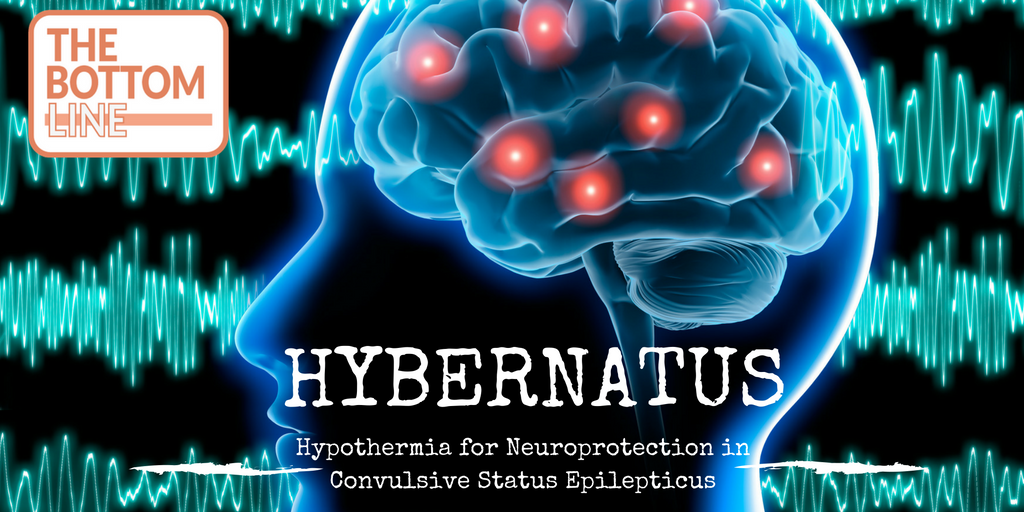HYBERNATUS

Hypothermia for Neuroprotection in Convulsive Status Epilepticus
Legriel S et al. N Engl J Med 2016;375:2457-67. DOI: 10.1056/NEJMoa1608193
Clinical Question
- In patients with convulsive status epilepticus, does the addition of therapeutic hypothermia to standard care improve neurological outcomes?
Design
- Randomised controlled trial
- Consecutive recruitment
- Computer-generated permuted blocks
- Multi-centre
- Open-labelled
- Parallel arm standard care
- Power calculation: 135 patients per group to demonstrate 20% difference in Glasgow Outcome Score (GOS) of 5 at 90 days (90% power)
- Assumed 40% in standard care group vs 60% in intervention group
- Intention to treat analysis
Setting
- 11 French ICUs
- Data collected: March 2011 – January 2015
Population
- Inclusion criteria:
- ≥18 years old
- Convulsive status epilepticus admitted to ICU defined as 5 minutes or more of continuous clinical seizure activity or more than two seizures without a return to baseline in the interval
- Admitted less than 8 hours after the onset of seizures
- Receiving mechanical ventilation
- Exclusion criteria:
- Full recovery from seizure (defined as a return to the baseline state of consciousness)
- Emergency surgery that would preclude therapeutic hypothermia
- Postanoxic status epilepticus
- Imminent death
- Do-not-resuscitate orders
- Bacterial meningitis was added in January 2013
- Participant numbers
- 270 patients enrolled. 2 withdrew consent
- 138 assigned to intervention group and 130 to control group
- Baseline characteristics:
- Median age 57
- 65% male
- 49% known history of epilepsy
Intervention
- Target core temperature of 32 to 34°C as rapidly as possible post randomisation
- Target temperature maintained for 24 hours
- Hypothermia induced with ice-cold IV fluids at 4°C, maintained with ice packs at the groin and neck and a cold-air tunnel around the patient’s body
Control
- No target temperature set
For both intervention and control group
- Propofol as sedative agent
- Continuous EEG monitoring within 2 hours of randomisation
- Continued for at least 48 hours or normothermia in the intervention group
- Standard EEG extracted and intepreted by neurophysiologists
- If EEG-proven seizure activity seen, propofol administered to achieve burst-suppression pattern for 24 hours
- Continuous core temperature monitoring by oesophageal probe
Outcome
- Primary outcome: GOS score of 5 (indicating survival with no or minimal neurological deficit)
- No significant difference: 49% in intervention vs 43% in control (CI 0.75 – 1.99, p=0.43)
- Secondary outcomes: comparing intervention vs. control group
- No significant difference in:
- ICU mortality: 9% vs 12%, odds ratio 0.83 (CI 0.38 – 1.82, p=0.64)
- Hospital mortality: 12% vs 15%, odds ratio 0.81 (CI 0.40 – 1.64, p=0.55)
- Mortality at 90 days post discharge: 13% vs 15%, odds ratio 0.86 (CI 0.43 – 1.72, p=0.67)
- Total seizure duration: Median 75min vs 90min, p=0.26)
- Refractory status epilepticus on day 1: 31% vs 50%, odds ratio 0.68 (CI 0.40 – 1.15, p=0.15)
- Super-refractory status epilepticus, defined as ongoing or recurrent status epilepticus between 24 and 48 hours after the initiation of anaesthetic treatment: 17% vs 23%, odds ratio 0.64 (CI 0.34 – 1.159, p=0.16)
- Length of stay in ICU: Median 8 days vs 7 days, p=0.44
- Length of stay in hospital: Median 21 days vs 19 days, p=0.89
- Incidents of 1 or more adverse events: 85% vs 77%
- Significant difference in progression in EEG-confirmed status epilepticus: 11% vs 22%, odds ratio 0.4 (CI 0.20 – 0.79, p=0.009)
- No significant difference in:
Authors’ Conclusions
- In critically ill patients with convulsive status epilepticus receiving mechanical ventilation, the addition of therapeutic hypothermia to standard antiepileptic therapy showed no significant benefit with respect to good functional outcome
Strengths
- RCT
- Incidence of primary outcome in control group in line with power calculations
- Standardised initial treatment with anti-epileptic drugs similar in both groups
- Standardised sedation protocol
- Separation of temperature between intervention and control group achieved
- Hypothermia target achieved in 98% of patients randomised to intervention group
Weaknesses
- Only 25% of patients were in status epilepticus as defined at the time of randomisation
- Early utilisation of hypothermia not standard practice
The Bottom Line
- This study only looked at patients with status epilepticus requiring mechanical ventilation. Despite the early use of induced hypothermia, the lack of clear functional benefit means that I would continue not to use it in my current practice.
External Links
- [article] Hypothermia for Neuroprotection in Convulsive Status Epilepticus
- [FOAMed] St. Emlyn’s. Hypothermia in status epilepticus
- [FOAMed] CC Nerd-The Case of the Uncertain Surrogate CC Nerd-The Case of the Uncertain Surrogate
Metadata
Summary author: @avkwong
Summary date: 4th January 2017
Peer-review editor: @stevemathieu75




Pingback: Hypothermia in status epilepticus. St.Emlyn's - St.Emlyn's
Pingback: SGEM#199: Therapeutic Hypothermia – What is it Good For? | The Skeptics Guide to Emergency Medicine